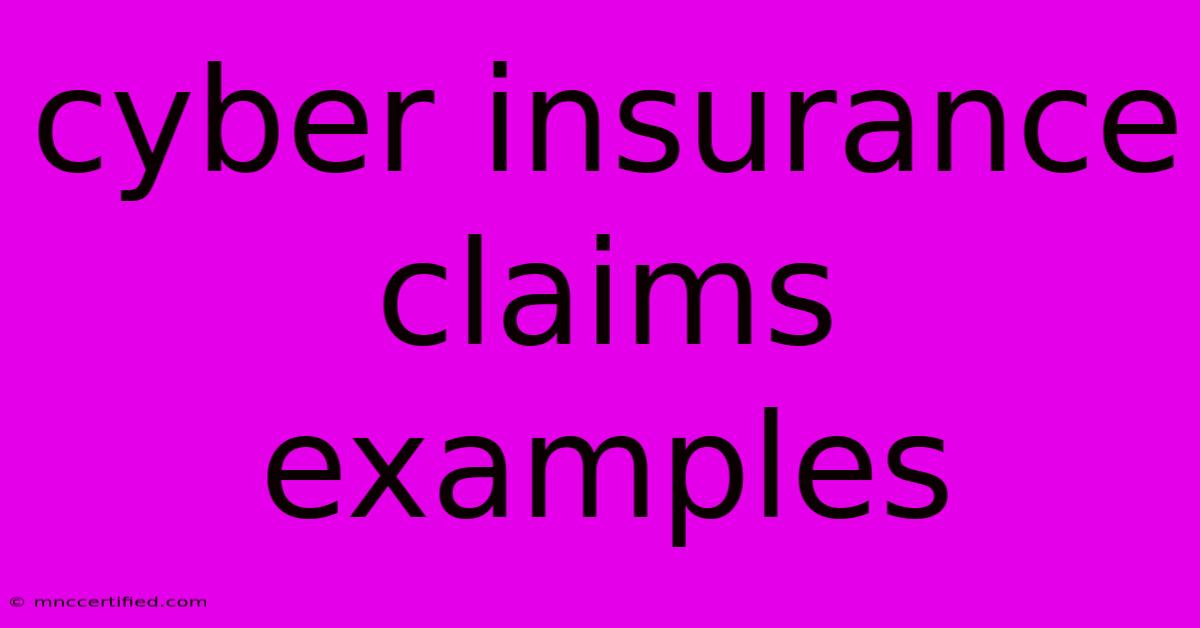Cyber Insurance Claims Examples

Table of Contents
Cyber Insurance Claims Examples: Real-World Scenarios and What They Mean for You
Cyberattacks are no longer a matter of "if," but "when." The rise of sophisticated cyber threats means businesses of all sizes, and even individuals, are increasingly vulnerable. This is why cyber insurance is becoming a crucial part of any comprehensive risk management strategy. But understanding what constitutes a claimable event can be tricky. This article explores several cyber insurance claims examples, illustrating the types of incidents that are typically covered and providing insights into the claims process.
Common Cyber Insurance Claim Scenarios
Cyber insurance policies vary, so it's crucial to understand your specific coverage. However, many policies cover a range of incidents. Here are some common examples:
1. Data Breach and Notification Costs
This is perhaps the most common type of cyber insurance claim. A data breach occurs when sensitive information, such as customer data, employee records, or financial information, is compromised. This could involve:
- Phishing attacks: Employees tricked into revealing credentials, leading to unauthorized access.
- Malware infections: Ransomware or other malicious software encrypting data or stealing information.
- Third-party vulnerabilities: A compromised vendor exposing your data.
A successful claim would cover the costs associated with:
- Notification: Contacting affected individuals and regulatory bodies.
- Credit monitoring: Providing affected individuals with credit monitoring services.
- Legal and forensic investigation: Hiring experts to determine the extent of the breach and its cause.
- Public relations: Managing the reputation damage resulting from the breach.
Example: A small business experiences a ransomware attack, leading to the encryption of customer order data. Their cyber insurance policy covers the costs of ransomware decryption, forensic investigation, legal counsel, notification costs to affected customers, and credit monitoring services.
2. Business Interruption and Extortion
Cyberattacks can cripple a business's operations, leading to significant financial losses. Business interruption insurance covers the lost revenue and extra expenses incurred due to a cyber incident that forces a temporary shutdown. This also includes extortion, such as ransomware demands.
- Ransomware attacks: Disrupting operations and demanding payment for data decryption.
- Distributed Denial of Service (DDoS) attacks: Overwhelming a company's website or network, making it inaccessible to customers.
- System failures due to a cyberattack: Catastrophic system failure following a successful intrusion.
Example: A manufacturing company suffers a DDoS attack, rendering its online ordering system inoperable for several days. Their cyber insurance policy covers the lost revenue during the downtime and the costs of mitigating the attack and restoring services.
3. System Restoration and Recovery
Cyberattacks often require significant time and resources to repair. System restoration coverage helps businesses recover from data loss and system damage.
- Data recovery: Recovering data from backups or utilizing data recovery services.
- Hardware and software replacement: Replacing damaged hardware and software.
- IT support: Hiring IT professionals to restore systems and networks.
Example: A law firm's servers are compromised, resulting in data loss. Their cyber insurance policy covers the costs of data recovery from backups, system restoration, and the fees of IT experts.
4. Privacy Liability
Regulations like GDPR impose strict requirements for data protection. A data breach can lead to significant fines and legal costs. Privacy liability coverage helps businesses handle these situations.
Example: A healthcare provider experiences a data breach, exposing patient medical information. Their cyber insurance policy covers the legal fees associated with defending against a lawsuit and potential regulatory fines.
Tips for a Successful Cyber Insurance Claim
- Maintain detailed records: Keep meticulous logs of security measures, incident responses, and financial losses.
- Report incidents promptly: Notify your insurer immediately after a cyberattack.
- Cooperate with the investigation: Follow your insurer's instructions and provide all necessary information.
- Choose a reputable insurer: Select an insurer with a strong track record of handling cyber claims.
- Regularly review your policy: Ensure your coverage aligns with your evolving risk profile.
Conclusion
Understanding the different types of cyber insurance claims examples is crucial for businesses and individuals to effectively manage their cybersecurity risks. By understanding the coverage provided by their policies and following best practices for claim filing, organizations can minimize the financial and operational impact of cyberattacks. Don't wait until an incident occurs—protect your business today with comprehensive cyber insurance. Remember to consult with a qualified insurance professional to determine the best policy for your specific needs.

Thank you for visiting our website wich cover about Cyber Insurance Claims Examples. We hope the information provided has been useful to you. Feel free to contact us if you have any questions or need further assistance. See you next time and dont miss to bookmark.
Featured Posts
-
Height Extremes A Meeting
Nov 23, 2024
-
Maxum Specialty Insurance Group
Nov 23, 2024
-
Progressive Insurance In Tucson
Nov 23, 2024
-
Thanksgiving Travel Forecast Rain Or Snow
Nov 23, 2024
-
Prince Guitar Sells For 381 000
Nov 23, 2024